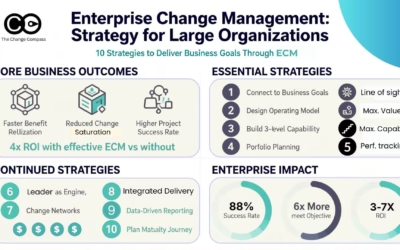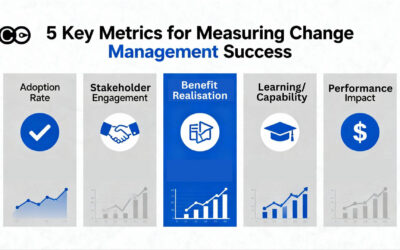The Strategic Blind Spot in Enterprise Change Management
In today’s volatile business environment, enterprise change management (ECM) functions are under mounting pressure to prove their value. Despite the proliferation of change initiatives – ranging from digital transformation to operational restructuring – many organizations still treat ECM as a support function, primarily focused on capability building and project resourcing. This narrow focus, while important, leaves a critical gap: ECMs are often missing the opportunity to deliver the highest value services – enterprise change measurement and strategic/operational planning.
The Current State: A Tactical Focus
Most ECM functions have evolved to emphasize two core activities:
- Capability Building: Developing change skills and mindsets across the business, often through training, coaching, and establishing communities of practice
- Project Resourcing: Supplying skilled change practitioners to projects, ensuring adequate coverage for major initiatives.
While these activities are foundational, they tend to position ECM as a cost centre rather than a strategic partner. When business conditions tighten, these functions are often among the first to face budget cuts or downsizing, as their value is often perceived as indirect or non-essential to core business outcomes.
The Consequence: Vulnerability in Uncertain Times
This tactical orientation creates a paradox. As organizations face more frequent and complex change, the need for robust change management increases. Yet, when times are tough, ECM functions are often scaled back precisely when their expertise could be most valuable. This cycle undermines organizational resilience and readiness, leaving businesses exposed to greater risks during periods of transformation.
The Missed Opportunity: High-Value Services
The most significant gap lies in the underutilization of ECM’s potential to deliver high-value, strategic services. These include:
- Enterprise Change Performance: Systematically tracking and analyzing the impact, readiness, and adoption of change across the organization.
- Strategic and Operational Planning: Partnering with strategy teams and business leaders to anticipate change impacts, model scenarios, and inform decision – making.
By not prioritizing these services, ECM functions miss the chance to influence the organization at the highest levels – where decisions about direction, investment, and risk are made.
Why the Gap Exists
Several factors contribute to this strategic blind spot:
- Historical Positioning: ECM has traditionally been seen as an “enabler” rather than a “driver” of business outcomes.
- Lack of Data: Without robust change measurement, it’s difficult to provide the insights needed for strategic planning and governance.
- Resource Constraints: With limited budgets and headcount, ECMs often default to immediate project demands rather than longer-term, enterprise-wide priorities.
- Digital Immaturity: Many organizations lack the digital tools to capture, analyze, and sustain data-driven change insights, further limiting ECM’s strategic contribution.
The Path Forward
To break this cycle, ECM functions must reposition themselves as indispensable partners in enterprise strategy and planning. This requires a deliberate shift from a narrow focus on capability and resourcing to a broader remit that includes measurement, insight generation, and strategic advisory services. The following sections will explore how ECMs can leverage data and digital tools to deliver these high-value services, and how this repositioning can fundamentally enhance their role in change governance and business planning.
Elevating Enterprise Change Management – From Tactical Support to Strategic Insight
The Power of Change Measurement
To become a true strategic partner, ECM functions must anchor their value proposition in robust, enterprise-wide change measurement. This means moving beyond anecdotal feedback and isolated project metrics to a disciplined, data-driven approach that captures the full spectrum of change activity, impact, and readiness across the organization.
What Is Enterprise Change Measurement?
Enterprise change measurement is the systematic collection, analysis, and interpretation of data related to all change initiatives within an organization. This includes:
- Change Volume and Velocity: How many changes are occurring, and at what pace?
- Cumulative Impact: What is the aggregated effect of concurrent changes on teams, processes, and customers?
- Readiness and Adoption: How prepared are stakeholders for upcoming changes, and how well are new ways of working being adopted?
- Risk and Saturation: Where are the pressure points? Which business units or functions are at risk of change fatigue or resistance?
By establishing a comprehensive measurement framework, ECMs can provide leaders with a “change performance dashboard” that highlights risks, opportunities, and areas requiring intervention.
Why Measurement Matters
- Objectivity: Data – driven insights replace subjective opinions, enabling more informed decision – making.
- Prioritization: Leaders can see where to focus resources for maximum impact and where to pause or sequence initiatives to avoid overload.
- Accountability: Clear metrics enable tracking of change outcomes, supporting continuous improvement and demonstrating the tangible value of ECM.
- Proactive Risk Management: Early identification of adoption risks or readiness gaps allows for timely mitigation, reducing the likelihood of failed initiatives.
Leveraging Digital Tools for Continuous Insight
The digital revolution has transformed every aspect of business, and ECM should be no exception. Modern digital tools – ranging from enterprise change management platforms to advanced analytics and AI – make it possible to capture, analyze, and visualize change data in real time.
Key Capabilities of Digital Change Platforms
- Automated Data Capture: Streamline the collection of change activity and sentiment data with less manual effort.
- Dashboards and Visualizations: Provide leaders with intuitive, up-to-date views of change activity, risk hotspots, and adoption trends.
- Scenario Modelling: Use predictive analytics to model the impact of proposed changes on different parts of the organization, supporting better planning and resource allocation.
- Feedback Loops: Enable continuous input from stakeholders, surfacing emerging issues and opportunities for course correction.
Building the Digital Foundation
To realize these benefits, ECMs must:
- Invest in the Right Tools: Select platforms that fit the organization’s size, complexity, and digital maturity.
- Establish Data Governance: Ensure data quality, security, and privacy, with clear ownership and processes for managing change data.
- Build Analytical Capability: Develop skills within the ECM team to interpret data, generate insights, and translate findings into actionable recommendations.
Partnering for Strategic and Operational Planning
Armed with robust data and digital insights, ECMs are uniquely positioned to partner with strategy teams and senior leaders in both strategic and operational planning cycles.
Strategic Planning
- Change Impact Modelling: Collaborate with strategy leaders to model the implications of major strategic shifts – such as mergers, restructures, or technology rollouts – on people, customers, partners and culture/behaviours.
- Resource Forecasting: Advise on the change management resources required to support planned initiatives, ensuring adequate capacity and capability.
- Risk Assessment: Highlight potential adoption risks and readiness gaps, enabling proactive mitigation and more resilient strategic execution.
Operational Planning
- Change Portfolio Management: Work with business units to sequence and prioritize initiatives, reducing change saturation and maximizing adoption.
- Readiness/Adoption Assessments: Provide data – driven readiness assessments to inform operational plans, ensuring teams are prepared for upcoming changes.
- Performance Tracking: Monitor adoption and impact metrics post – implementation, feeding lessons learned back into future planning cycles.
Unlocking the Full Value of ECM
By moving up the value chain – from tactical support to strategic insight – ECMs can fundamentally reshape their role within the organization. This shift not only enhances the effectiveness of change initiatives but also positions ECM as a critical enabler of business strategy, resilience, and long-term success.
Embedding Enterprise Change Management in Governance and Planning – Unlocking Strategic Value
From Insight to Influence: The New Role of ECM
When enterprise change management (ECM) functions leverage robust measurement and digital insights, they move from being tactical enablers to strategic influencers. This transition is not just a shift in activity but a fundamental change in how ECM is perceived and positioned within the organization. The true value of ECM emerges when it is embedded in the core governance and planning processes, shaping decisions that drive business performance and resilience.
Integrating ECM Into Change Governance
Change governance is the system by which organizations oversee, prioritize, and manage change initiatives. Traditionally, ECM’s role in governance has been limited, often reactive – providing support when asked or responding to issues as they arise. However, with access to enterprise-wide change data and predictive analytics, ECM can now play a proactive, advisory role.
Key contributions of ECM in change governance include:
- Portfolio-level risk assessment: By providing a “change performance dashboard,” ECM can help governance forums visualize where cumulative change is creating risk, enabling more informed decisions about sequencing, prioritization, and resource allocation.
- Evidence-based recommendations: ECM brings objective data to the table, shifting conversations from opinion-based debates to fact-based decision-making.
- Continuous monitoring: Real-time dashboards and feedback loops allow governance bodies to track adoption, readiness, and business impact, supporting agile responses to emerging issues.
This approach aligns with the Unified Value Proposition for change management, which emphasizes the integration of technical and people aspects to achieve both project objectives and organizational benefits. When ECM is seen as a structured, data-driven discipline, its credibility and influence within governance structures increase significantly.
Shaping Strategic and Operational Planning
The value of ECM is amplified when it is involved early in the strategic and operational planning cycles. By partnering with strategy and business leaders, ECM can:
- Model change implications: Use scenario analysis to forecast the impact of strategic decisions on people, processes, and culture, identifying potential bottlenecks or adoption risks before they materialize.
- Inform resource planning: Advise on the change management resources and capabilities required to support the planned portfolio, ensuring adequate investment and reducing the risk of under – resourcing critical initiatives.
- Enhance readiness and adoption: Integrate readiness assessments and adoption metrics into operational plans, increasing the likelihood of successful outcomes and accelerating benefit realization.
This proactive involvement transforms ECM from a “nice-to-have” support function to an essential partner in delivering business strategy and managing risk.
Real-World Impact: Lessons from Leading Organizations
Organizations that have successfully repositioned ECM as a strategic partner demonstrate tangible business benefits. For example, a large financial services leader, integrated change management and project management, prioritized sponsorship, and leveraged data-driven insights to support multiple simultaneous transformations. The results included reduced risks of change saturation and release clashes, enhanced speed of planning and reduced operational disruptions.
This underscore the importance of:
- Early and ongoing ECM involvement in planning and governance
- A unified approach that combines technical and people – centric change management
- Data-driven decision – making as the foundation for ECM’s strategic contribution
Sustaining the Strategic Role of ECM
To ensure ECM’s strategic value is sustained – even when business conditions become challenging – organizations must:
- Institutionalize ECM’s seat at the table: Make ECM participation in governance and planning forums a non-negotiable part of the operating model.
- Continue investing in digital tools and analytics: Maintain and evolve the digital infrastructure that enables continuous measurement and insight generation.
- Develop ECM talent: Build analytical, advisory, and business partnership skills within ECM teams to match their new strategic mandate.
The Future of ECM Is Strategic
As organizations navigate increasing complexity and accelerated change, the need for strategic, data-driven change management has never been greater. By focusing on high-value services, enterprise change measurement and strategic/operational planning, ECM functions can secure their place as indispensable partners in business success. This shift unlocks their full potential to drive sustainable transformation and competitive advantage.






